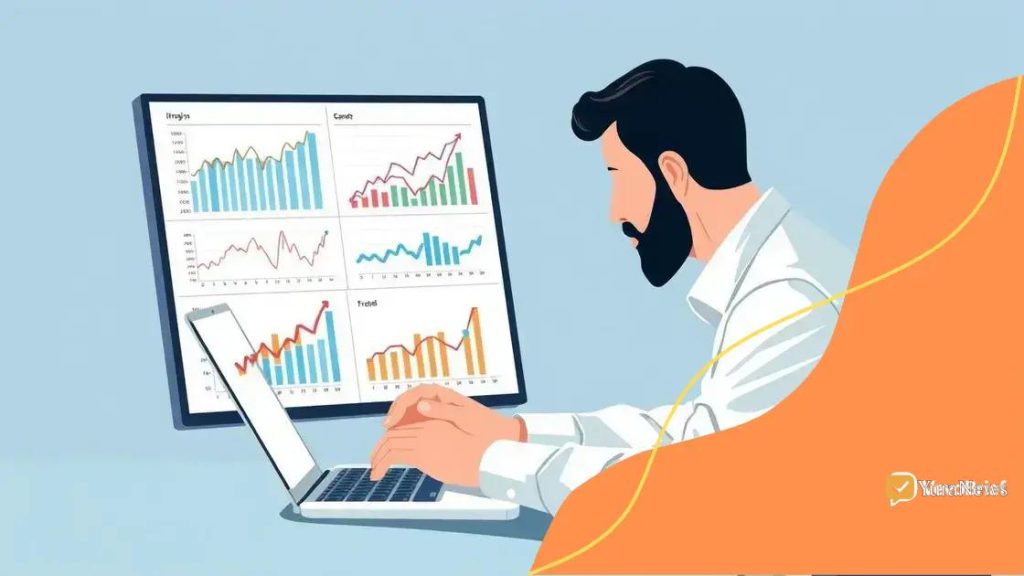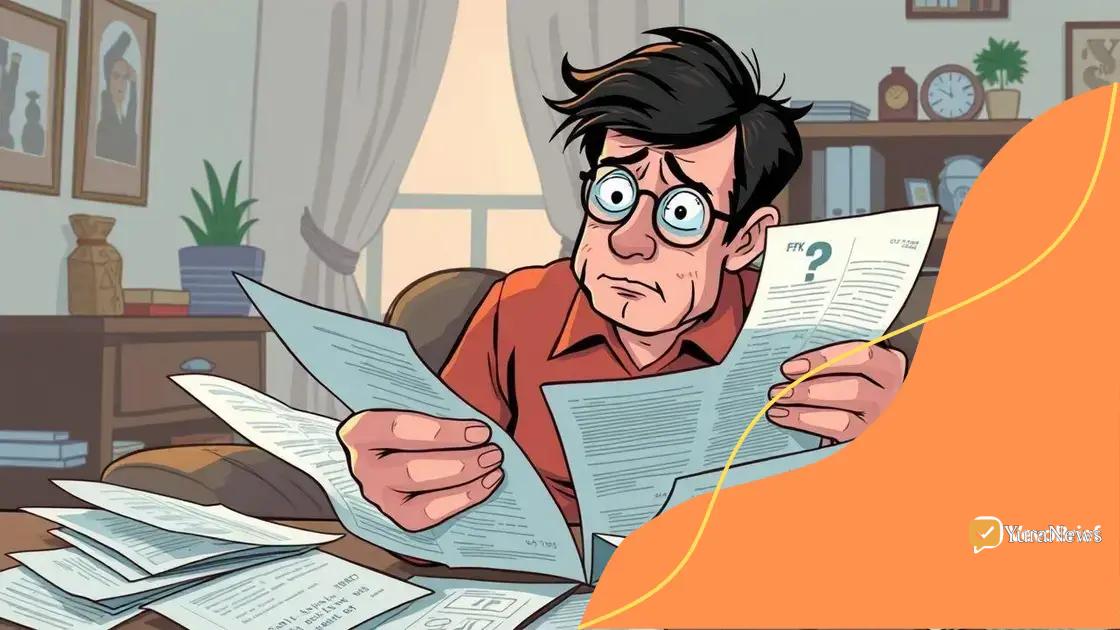Stagflation concerns lessen: what it means for you

Anúncios
Stagflation combines slow economic growth, high unemployment, and rising inflation, significantly impacting individuals by decreasing purchasing power and creating financial uncertainty.
Stagflation concerns lessen as new economic data emerges, creating a buzz among investors and consumers alike. Have you wondered how this will influence your financial decisions? Let’s dive in.
Anúncios
Understanding stagflation
To understand stagflation, we first need to grasp the concept of inflation itself. Inflation occurs when the prices of goods and services rise over time. However, stagflation is different because it combines inflation with stagnant economic growth and high unemployment.
Historically, stagflation has puzzled economists. While inflation usually indicates a booming economy, the lingering issues of stagnation and high unemployment challenge this correlation. So, what leads to stagflation?
Causes of stagflation
Several factors contribute to stagflation. It’s essential to recognize them:
Anúncios
- Supply shocks: Sudden increases in prices, such as oil price hikes, can cause production costs to rise.
- Poor economic policies: Misguided government interventions can hinder growth.
- Decreased consumer confidence: When consumers fear economic instability, spending drops.
These factors feed into a cycle, making it difficult for economies to recover. When costs are high and growth is weak, businesses struggle while consumers avoid spending.
Impact on individuals
Stagflation can create serious challenges for everyday people. When prices rise, the cost of living increases, and purchasing power decreases. Individuals may find that their wages do not keep pace with inflation, leading to tighter budgets and difficult financial choices.
This scenario can put strain on families, especially those on fixed incomes. They may face tough decisions about how to allocate limited resources. Furthermore, unemployment can rise, making job security a concern. So, what should we be mindful of in a stagflationary environment?
- Budget wisely: Focus on prioritizing essential expenses.
- Invest cautiously: Research before making significant financial moves.
- Stay informed: Keep abreast of economic news to adapt quickly.
As consumers navigate through these challenging times, understanding the ins and outs of stagflation will empower them to make informed decisions. Economic conditions can seem daunting, but knowledge is a powerful tool.
Economic indicators to watch
When navigating through economic uncertainty, it’s crucial to monitor specific economic indicators. These indicators provide insights into the overall health of the economy and can help you make informed decisions. Understanding these signs can guide your financial strategies, especially in a fluctuating market.
Key economic indicators
Several vital indicators can signal the direction of the economy:
- Gross Domestic Product (GDP): This measures the total value of goods and services produced in a country. A declining GDP indicates a shrinking economy.
- Unemployment rate: High unemployment suggests economic distress. Conversely, low unemployment signals a robust economy.
- Consumer Price Index (CPI): The CPI tracks changes in prices for a basket of goods. Rising CPI indicates inflation, which may raise concerns about stagflation.
- Interest rates: Set by the central bank, these rates influence borrowing and spending. Increased rates can cool an overheated economy.
Watching these indicators helps you anticipate economic trends that might impact your personal finances. For example, if GDP is falling, it could be wise to reassess your investments.
The importance of consumer confidence
Another significant factor is consumer confidence. This indicator reflects how optimistic people feel about the economy’s state. When confidence is high, people are more likely to spend, which can help stimulate growth.
However, if confidence decreases, it may lead to reduced spending and further economic slowdown. To keep a pulse on consumer sentiment, consider following surveys and analysis from reliable sources. Staying informed about trends can prepare you for potential challenges in a stagflation environment.
By monitoring these key economic indicators, you can better navigate through complexities and adapt to changes in the economic landscape. Remember that knowledge is power, especially in uncertain times.
How stagflation affects individuals

Understanding how stagflation affects individuals is essential for navigating tough economic times. When stagflation occurs, the combination of rising prices and stagnant economic growth can create challenging conditions for many people.
During periods of stagflation, individuals often face increased living costs, as consumer prices rise. This means that everyday essentials, such as food and gas, become more expensive. As prices increase, the purchasing power of your income decreases. This can lead to tough choices about budgeting and spending.
Impact on employment
In a stagflationary environment, job opportunities can decline. High inflation often leads to companies cutting back on hiring or even laying off workers to manage rising costs. This situation can lead to increased unemployment rates, making finding and keeping a job more challenging.
For those who remain employed, stagnant wages can be a concern. If salaries do not keep pace with inflation, workers may find it difficult to maintain their standard of living. This can create a sense of financial insecurity among individuals and families. Setbacks in job security may also hinder long-term financial planning or goal-setting.
Effects on savings and investments
Stagflation not only affects current finances but also impacts savings and investments. Inflation erodes the value of money over time, meaning that savings may no longer offer sufficient growth. Keeping cash in savings accounts might provide minimal interest, but it could be outpaced by inflation rates.
Individuals need to consider diversifying their investments. Investing in assets that generally hold their value during inflationary periods, such as real estate or commodities, can be essential. Staying informed about financial strategies can help mitigate the adverse effects of stagflation.
In conclusion, understanding the impacts of stagflation on individuals helps create awareness about personal financial strategies. Facing rising costs and stagnant growth can feel overwhelming, but knowledge allows for better planning and adaptation. Staying informed and ready to adjust can lessen the burden of these economic challenges.
Strategies for financial planning
In times of stagflation, having a solid financial plan is crucial. The combination of rising prices and stagnant growth can create uncertainty. To navigate this landscape, consider implementing a few key strategies to protect your finances.
First, it’s important to establish a budget that accounts for increased living costs. By tracking your expenses, you can identify areas where you may cut back. This might mean reducing discretionary spending, such as dining out, or finding more affordable alternatives for necessary items.
Prioritize saving
Building an emergency fund is another essential strategy. Aim to save at least three to six months’ worth of living expenses. This fund can serve as a financial cushion during turbulent times when job security may wane. Also, consider contributing consistently to a retirement account, as time and compound interest can enhance future savings.
- Automate your savings: Set up automatic transfers to your savings or investment accounts. This makes saving easier and more consistent.
- Evaluate your investments: In a stagflation environment, traditional stocks may falter. Adjusting your portfolio to include assets that typically perform better during inflation, like real estate or commodities, can be beneficial.
- Monitor expenses: Watch for price increases on frequently purchased items and adjust your budget accordingly.
Staying informed about economic trends will help you make proactive changes to your financial strategy. Educating yourself on financial literacy can guide you through uncertainties.
Flexibility is key
Being flexible with your financial strategies is vital. As the economy shifts, being willing to adapt your budget and financial goals keeps your plans relevant. Regularly reviewing your financial situation allows you to spot potential challenges early.
Ultimately, the goal is to create a sustainable financial plan that can weather the risks associated with stagflation. By prioritizing savings, monitoring expenses, and remaining adaptable, individuals can protect themselves against economic fluctuations.
Future outlook on inflation and growth
The future outlook on inflation and economic growth is a topic of great concern, especially as stagflation remains a possibility. Economists and analysts closely watch several factors that could influence these trends in the coming years.
One significant factor is government policy. Central banks play a crucial role in managing inflation through interest rates. If rates are kept low for too long, inflation may climb higher. Conversely, raising rates too quickly could stifle growth. Striking the right balance will be essential
Global economic conditions
Global events also influence inflation and growth. Supply chain issues, geopolitical tensions, and commodity prices can have wide-reaching effects. For example, disruptions in oil supply can lead to higher prices at the pump, affecting consumer spending and business costs.
As economies recover from recent challenges, growth may or may not keep up with inflationary pressures. Investors should pay attention to key signs that provide clues about future economic health.
- Job growth: A strong job market typically indicates economic health. Monitoring unemployment rates can provide insight into growth prospects.
- Consumer spending: When people spend, it drives growth. Trends in consumer confidence surveys can signal future spending behavior.
- Wage growth: If wages increase without significant inflation, purchasing power can improve, contributing to economic stability.
As we look ahead, it is essential to remain vigilant. Understanding the economic landscape involves following various indicators. Keeping informed about changes in inflation rates and economic policy can help individuals and businesses prepare for what might come next.
Adapting to change
Preparing for fluctuations means being adaptable in financial planning. Individuals should reassess their budgets and spending habits regularly. Businesses might adapt their strategies based on inflation trends to ensure long-term sustainability.
The future holds both opportunities and challenges regarding inflation and growth. Embracing change and staying informed will empower individuals to navigate the shifting economic landscape successfully.
FAQ – Frequently Asked Questions about Stagflation and Economic Planning
What is stagflation?
Stagflation is an economic condition characterized by slow economic growth, high unemployment, and rising prices (inflation).
How can I protect my finances during stagflation?
You can protect your finances by budgeting wisely, saving for emergencies, and diversifying your investments to include inflation-resistant assets.
What economic indicators should I monitor?
Key indicators to watch include inflation rates, unemployment rates, GDP growth, and consumer confidence levels.
Why is consumer confidence important?
Consumer confidence affects spending; if consumers feel optimistic about the economy, they are more likely to spend, driving economic growth.